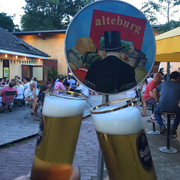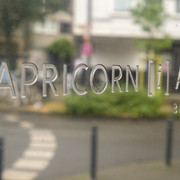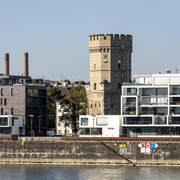Photos & Map
How would you like to arrive?
Details
Useful Information
Nearby
When you look at the Rhine today, flowing powerfully and broadly through the city of Cologne, the idea of a shallow stream arriving in Cologne seems absurd—this event, however, almost occured long, long ago. Father Rhine was seeking a new course, which would have meandered over Deutz only to return to its usual path at Mülheim. For Cologne’s prosperity through trade, this would have been a disaster. Thus, in the 12th century, the Poller Wiesen were created with plants and embankments, and later the Poller Köpfe, to ensure the Rhine remained navigable for trade through Cologne rather than veering away.
Today, the Poller Wiesen serve as a recreational area for walking, cycling, or exercising—and from here you can enjoy a fantastic view of Cologne, perhaps from a picnic blanket, like many locals do on sunny days. But beware: sheep occasionally graze on the Poller Wiesen to maintain the greenery naturally.
Massive boxes made of oak trunks, filled with basalt boulders, formed a several hundred-meter-long structure, about 8 meters wide and up to 3 meters above the water. Additionally, numerous old, damaged Rhine ships were sunk to further stabilize the Poller Köpfe. In 2003, the low water levels revealed two Dutch ships— a specific boat type from the 16th century. Therefore in 2005, the Poller Wiesen were registered as an archaeological monument.
Today, the Poller Wiesen serve as a recreational area for walking, cycling, or exercising—and from here you can enjoy a fantastic view of Cologne, perhaps from a picnic blanket, like many locals do on sunny days. But beware: sheep occasionally graze on the Poller Wiesen to maintain the greenery naturally.
Sightseeing where the Sun Shines Longer
The Poller Wiesen are centrally located yet off the beaten path, on the Deutz side. Easily accessible by bike or on foot via the south bridge—behind the Rheinauhafen—the meadows reward your efforts with a panoramic view of Cologne: crane houses, the Chocolate Museum, the Hohenzollern Bridge, and of course the Cologne Cathedral appear like an XXL live panorama postcard. Many locals prefer this view during the evening hours with a Kölsch and music, admiring Cologne in the light of the setting sun.Poller Köpfe: An Archaeological Monument
There’s no doubting the recreational value of the Poller Wiesen, but things get interesting beneath them as well. Here lie the remains of the historic Poller Köpfe, which—after initial fortifications were dismantled in 1479 due to disputes between the Cologne council and the archbishop, the owner of the area—were constructed from 1560 onward to keep the Rhine in its riverbed.Massive boxes made of oak trunks, filled with basalt boulders, formed a several hundred-meter-long structure, about 8 meters wide and up to 3 meters above the water. Additionally, numerous old, damaged Rhine ships were sunk to further stabilize the Poller Köpfe. In 2003, the low water levels revealed two Dutch ships— a specific boat type from the 16th century. Therefore in 2005, the Poller Wiesen were registered as an archaeological monument.
Poller Wiesen as an Open-Air Stage
A lot more modern and livelier are the Poller Wiesen during the summer months, when a variety of events take place in the expansive area—from church gatherings to fish festivals in memory of the Poller Mayfish tradition, to PollerWiesen, a festival for house, techno, and electro that first took place as an open-air party here in 1993. Since 2013, the festival has been held regularly in the youth park, attracting thousands.Useful Information
Eligibility
for Groups
for Class
for families
for individual guests
Payment Options
Entrance Free
Parking facilities
The walk from the stop Raiffeisenstraße (tram line: 7) to the Poller Wiesen takes about 10 minutes.
Nearby









